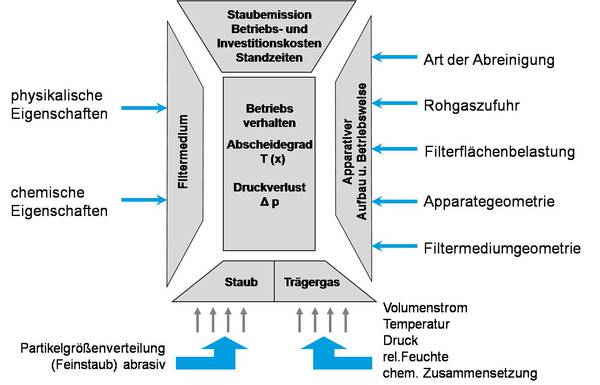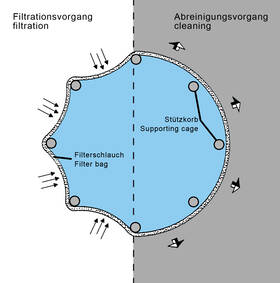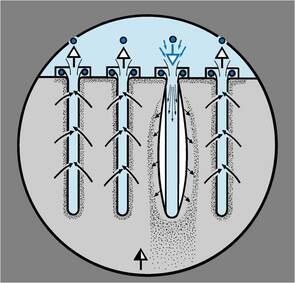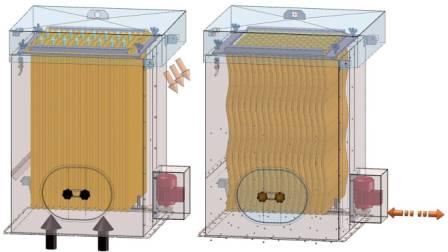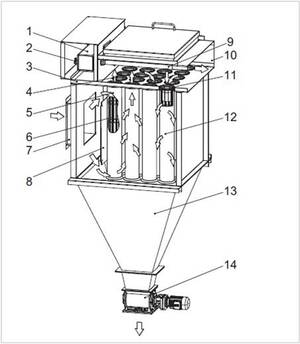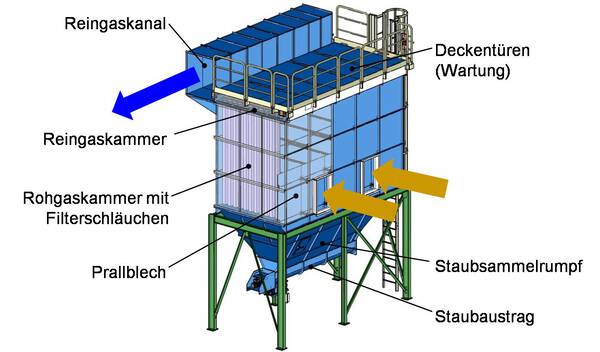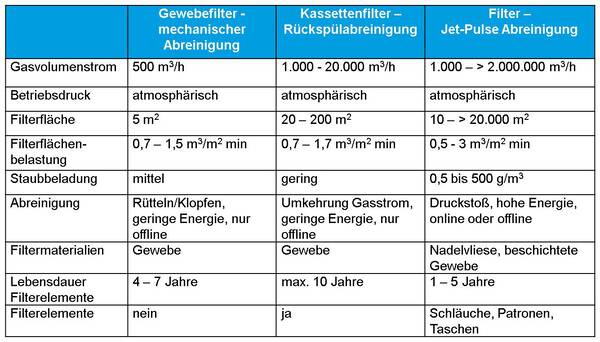Regenerable filters
The separating systems are basically gravity separators, centrifugal separators; wet separators; Electric separators, and filtration separators to choose from. Filtration separators are divided into storage filters and regenerable filters, with the latter playing a dominant role in the category of filtration separators due to their advantages. The large intensive filter lexicon for dedusting provides detailed information on regenerable filters.
Characteristics of regenerable filters
So-called regenerable filters are used to separate solid particles from gases when high concentrations of dust-laden exhaust air (up to 200 g/m³) are to be cleaned. The cleaning effect is based on the so-called surface filtration. The particles are mainly separated on the surface of the filter media on the particle layer (dust cake) that forms. After reaching a specified pressure drop or at fixed intervals, the filter media are cleaned so that the filtration process can be repeated periodically. The separated dust can be recovered.
The designs of regenerable filters differ in the geometric arrangement of the filter media, the gas flow, and the type of cleaning.
A further subdivision of filtering separators is based on the type and packaging of the filter material. With regard to the type of filter media, a distinction is made between bag filters, bag filters, cartridge filters, lamella filters, and cassette filters.
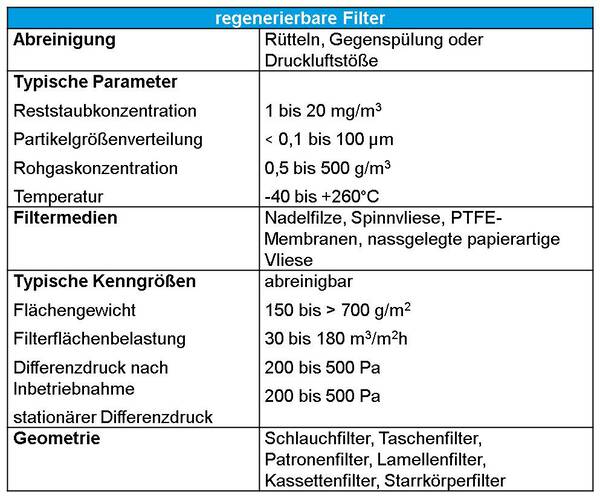
The geometry of bag filters, bag filters, cartridge filters, lamella filters, and cassette filters
- In bag filters, the filter element is usually a cylindrical bag. The filter hoses are manufactured in different diameters and lengths. Bag filters are used for the filtration of exhaust air at low and medium temperatures up to approx. 250 °C, the bag fabric holds back the dust as it flows through. The filter hoses are cleaned regularly – mostly by compressed air pulses. The cleaning effect of the compressed air pulse is additionally intensified by the sudden inflation of the filter hose. Bag filters are therefore particularly suitable for sticky or strongly adhesive dust.
- Pocket filters are used to remove dust from small amounts of gas. The filter medium is stretched over a flat, plate-shaped frame that is open on one side for the clean gas outlet. The flow is from outside to inside. The filter pockets are cleaned regularly – mostly by compressed air pulses. The cleaning effect of the compressed air pulse is additionally intensified by the sudden inflation of the filter pocket. This effect is only minimally lower with the bag filter than with the bag filter. Pocket filters are therefore also particularly suitable for sticky or strongly adhesive dust.
- Cartridge filters are an increasingly popular alternative to bag filters. The filter medium is folded in a star shape and placed on a cylindrical support basket. The flow takes place from the outside to the inside, cleaning by a pressure surge or low-pressure flushing. Cartridge filters are only used for dust that is easy to clean, otherwise, the folds will become clogged with dust.
- Lamella filters are an alternative to bag filters. Two folded filter media are placed on each other and glued or welded together at their contact points. The flow takes place from the outside to the inside, cleaning by a pressure surge or low-pressure flushing. Lamella filters are only used for dust that is easy to clean, otherwise, the folds will become clogged with dust.
- With cassette filters (“HEPA filters”), the dust-laden gas usually enters the raw gas chamber of the filter housing in the lower part – this is where pre-separation takes place – and first flows through the first filter stage. The fine dust that is carried along is separated on the outside of the folds of the filter cassette. The filter cassette is cleaned pneumatically. A nozzle tube slowly moves back and forth across the entire width and length of the filter cassette. The compressed air blows the filter cartridge downwards and frees the filter elements from dust. The cleaned gas from the first filter stage can optionally flow through a second, uncleaned filter stage. (security filter, police filter)
How filtering separators work
The particle-laden gas usually flows through the filter elements from the outside: The filtrate is deposited on the outside of the filter media by the airflow. A layer of dust – the so-called filter cake – builds up. The filter media must be cleaned periodically. For cleaning, the dust cake is detached again by short compressed air impulses or mechanical shaking movements, backflushing with air, or short compressed air impulses. The layer of dust falls down, for example into a collection funnel that is emptied regularly. (e.g. via a rotary valve)
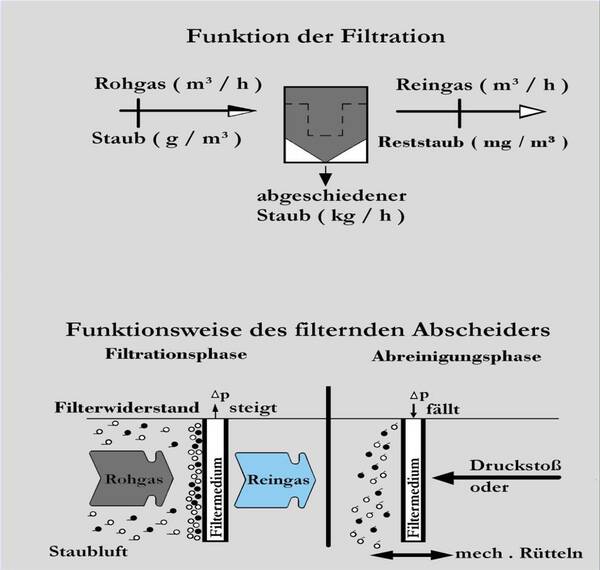
Operating performance filtering separators
The operating behavior depends on a large number of influencing factors: structure of the filter system, type, and design of the filter medium, mode of operation of the system, properties of the particles, and properties of the carrier gas

Cleaning mechanisms Dust separator
During the mechanical separation of dust particles and gas at the filter element, the growing layer of dust on the surface of the filter element creates a differential pressure (filter resistance). In order to avoid exceeding a certain differential pressure (usually < 1,500 Pa), the filter elements must be cleaned periodically.
In addition to the shape and arrangement of the filter media, the type of cleaning is the central design feature of a filter. The mechanical movement of the filter medium, the reversal of the gas flow, the transfer of momentum to the filter cake, and combinations of these mechanisms are considered cleaning mechanisms.

- Filtering and cleaning process of a compressed air-cleaned filter hose

- The cleaning process is in online mode. Rows 1, 2, and 4 of the hoses are in the filtration process, while row 3 of the hoses are being cleaned at the same time.

Regenerable filters with mechanical cleaning
The cleaning takes place with the help of a motor-operated vibrating device. With automatic cleaning, when the maximum filter resistance is reached or after a specified period of time, a motor starts up, causing the filter element to vibrate. The filter cake detaches from the filter fabric and falls down into a collection container that is regularly emptied or removed. Cleaning can only take place when the filtration mode is switched off (offline cleaning).
The filter media are heavily mechanically stressed when they are cleaned by shaking. Since vibrating filters may only be run discontinuously and are therefore not designed for continuous use, the filter media can – depending on the mode of operation – have a service life of up to 5, rarely even up to 7 years.

Regenerable filters with backwash cleaning
Backwash cleaning is used for mechanically sensitive filter media (e.g. filter cassettes) that would be damaged by shaking or jet-pulse cleaning. The cleaning is carried out by a partially directed flow reversal, whereby the filter medium is gradually blown off from the clean gas side, the dust cake is detached and transported downwards. Here, too, cleaning can only take place offline.
The filter system is usually designed in several chambers and cleaned chamber by chamber (offline cleaning). Due to their low mechanical stress, the filter media can have a service life of several years.
Regenerable filters with jet pulse cleaning
The most frequently used and most modern form of cleaning for filtration separators is the pressure surge method (jet pulse cleaning). In the meantime, this type of cleaning has largely become the standard. With Jet-Pulse systems, cleaning is carried out by means of an intensive blast of compressed air, which suddenly reverses the direction of flow, causing the filter elements to swell up briefly and the filter cake to be detached by impulse transmission.
The filter media (e.g. hoses or bags) are flown through from the outside to the inside during the filtration phase; a support frame gives the element the necessary stability. Depending on the amount of dust, cleaning is carried out by pressure surges every 1 to 10 minutes; normally regulated by measuring the filter differential pressure.

1 compressed air tank
2 diaphragm valve
3 intermediate floor for holding the filter media
4 clean gas chamber
5 Filtering hose
6 support basket
7 raw gas inlet
8 Baffle plate for gas flow distribution
9 nozzle stick
10 clean gas outlet
11 inlet nozzle
12 Filter hose during cleaning
13 dust collection room
14 dust discharge
Structural design of filtering separators
Filtration separators basically consist of:
- Filter head with regeneration device (today usually compressed air cleaning)
- Intermediate floor to accommodate the filter elements
- filter elements
- Housing
- dust collection room
- Dust discharge in different versions
- Additional components, e.g. B. cleaning control, discharge organs, etc
Typical construction of a bag filter

Typical design parameters for filters with mechanical cleaning, backflush cleaning and jet pulse cleaning

